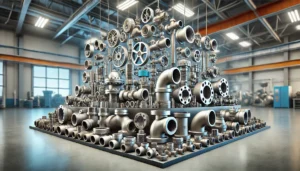The ability to track the use of material is essential to the fabrication process in various industries, and especially in Oil and Gas where the quality and reliability of piping together with equipment is critical. It refers to the capacity to follow, at any stage, the pipes, fittings, flanges and plates, Their history in terms of the place they have been used and where they were manufactured. This practice ensures that the materials used are as per required standards and such specifications so that the safety and efficiency of the end product is improved.
So, what actually is Material Traceability?
Material Traceability means forming a system which ties each piece of material with its corresponding Material Test Certificate. With such material traceability, the supplier of the material, the heat number, etc, can easily be located. Traceability works in a manner that ensures accuracy and responsibility in the processes, thus materials can be monitored throughout their life cycles.
Why is Material Traceability Important?
The importance of material traceability in fabrication and operation is simply immense. It is tremendously beneficial for the detection of bad materials even after the fabrication is completed. For example, if there is a problem with heat-treatment or metallurgy of any batch on a flange, flanges can be traced back and replaced with new ones. The component traceability alone reduces the chances of possible equipment failure and enhances the safety of the operation.
Another aspect that can be taken care of through proper materials research is the quality of the produced materials. Proper record keeping by the manufacturers particularly allows them to show the evidence needed to meet the regulatory and customer demands. This is advantageous in building confidence to the clients as well as reduces the time taken during audits and inspections.
In addition, traceability makes maintenance and repairs of the process plant during its life cycle less complicated. When it is necessary to change a component part, for example, engineers do not need to search around for required materials or examine everything in the workshop. The traceability system makes it easy for them to find the material. Time and cost are valuable assets in these situations.
How to Maintain Material Traceability?
There are few interventions for material traceability starting from the material delivery to fabrication and finally installation.
Inward Material Inspection
The fabrication process begins with an inward inspection of purchased materials to ensure that they are conforming to the requirements. For that every material must have MTC accompanying that material to ensure that it meets the requirements of the project before it is certified for usage in fabricating.
Marking and Material Identification
Material identification using marking attributes such as part or material ID is done to casts, pipes, plates etc, prior to fabrication. Marks can be made on components using metal stamps or paint markers for the purpose of ensuring adequate processing of each the component without the requirement of the manufacturers marking to the components.
Fit-up Inspection
During construction of components such as pipes, flanges and elbow, they are all together marked and photographed during a fit-up inspection which results to an adequate record being prepared. It contains a lot of information among which are important such as heat numbers of the items to which the items remain together. For instance, in the case of a piping spool made up of a flanged pipe and elbow, details such as the material type of the flanged elbow and height dimensions are recorded before the component is welded. These documents are important for the reason that when the components of the system become integrated into the advanced structure, there will be changed more difficulty to acquire the relevant marks or tracing information.
Material Traceability of Components After Assembly
Once the components are welded, they need to be traceable. A fit-up report involves a bill of documents such as part numbers, descriptions of parts of the assembly and heat numbers. Such info is documented on the line history sheet which helps in finding the traceability of welded assembly.
The tagging of spools with metal tags or the painting of spool numbers inside the pipes helps to enhance this traceability. This is to ensure that materials are identifiable during or after the installation/ painting so that there is traceability for the whole project.
What is the Importance of Material Traceability
There are a number of advantages that material traceability brings which when summed up enhances reliability of the fabrication process. This is so because the materials that have defects are able to be traced and replaced thus eliminating downtime or accidents caused by such defective materials. In addition, with the help of traceability the requirements in quality are easily adhered to and this in turn builds customer’s trust and compliance to the regulations is achieved.
In the course of plant operation, Maintenance and repairs are made easier by the use of traceability. The engineer can find the parts which need replacement quickly and this saves time and resources for repairs. Providing a good traceability system improves the reliability of the plant which is indeed crucial for safe and effective operation of plants.
Conclusion
The importance of Material Traceability cannot be stripped away, especially in the Oil and Gas sectors. It allows identifying defective items, improves the likelihood of complying with the quality standards, and ensures the piping and equipment maintenance is easier and simpler, thus increasing the overall reliability and safety of the equipments and systems. An effective and robust traceability system doesn’t just protect the process plant alone; it also instills confidence among stakeholders and becomes integral to the quality assurance philosophy of fabrication.










